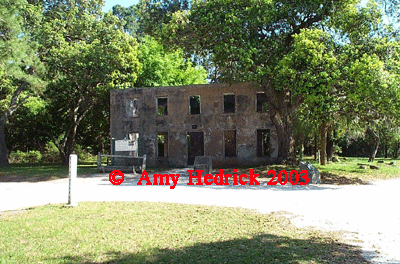

Horton House

|
William Horton, "Undersheriff of Herefordshire," England, came to Georgia in 1736. He built this building for his plantation residence and it was his home until his death in 1749. Major Horton succeeded Oglehtorpe as commander of the regiment of British troops stationed here. "He shined in war and in peace, in public and in private stations." Given by his descendants.
|
|
The Horton House was originally built around 1736 and was rebuilt in 1742/3 after the Spaniards destroyed it following the battle of Bloody Marsh. This is the oldest home, still standing, on Jekyll Island, and has been lived in and owned by many prominent folks, such as Clement Martin from about 1768 to 1784, Richard Leake from 1784 to 1792, and lastly, the most important family, whose cemetery is just across the road, Christophe Poulain duBignon from 1792 until the Jekyll Island Club opened in 1886. The original home was a wooden structure, two stories, with a parlor, fire places on each end of the house, sleeping quarters upstairs, a front porch, and an upstairs balcony. The second home [pictured above] was modeled after the first home. But unlike the first home, this one was made of tabby, in hopes of thwarting another fire.
There were many other buildings in this area, a well, and a dock, however nothing remains of these outbuildings. Many crops were grown here, including barley and indigo. In the year 1749, Horton passed to his great reward, and a garrison of troops were housed at his plantation on Jekyll Island, thus making Jekyll a military outpost. During this time, Capt. Raymond Demere lived in the Horton House, treating Jekyll as his own plantation and even renaming Jekyll Creek "Demere Creek", he also repaired old buildings and built new ones. Demere remained on Jekyll until his death in 1766 when the land was passed onto Clement Martin. Mr. Martin, however, didn't want just the plantation, he wanted the whole island, but was told that he had to grant about 500 acres to Thomas Horton, Major Horton's youngest son. By about 1768, Clement Martin was officially granted the whole island. The Horton House has survived through the
American Revolution, the War Between the States, hurricanes, and time.
Around 1898 members o f the Jekyll Island Club started to preserve and restore the Horton House by coating the entire outside with concrete, putting in iron rods for support, erecting the walls that had fallen, and many more repairs. Due to this primitive restoration, the Horton House is still standing today. Modern renovations have been underway to further preserve the Horton House, as these primitive attempts at restoration are starting to cause damage to the original structure. You can see in the photo on the right that things are progressing this year. In the year 2000, the Friends of Historic Jekyll Island, in conjunction with the Georgia Department of Natural Resources Historic Preservation Department, have taken this house under their wing by funding a preservation study of the site. With the aid of this research, the Jekyll Island Authority was better able to determine what steps were necessary in saving this landmark and in April of 2001 they applied for a grant with the Save America's Treasures Funding. The project will also include archaeological digs to find any missing support structures, stabilization of the building, and conservation. This preservation is being sponsored by the grant from Save America's Treasures and the National Park Service Department of the Interior. |
Home
Contact
Site Map
Copyright ©GlynnGen.com All Rights Reserved
Material on this site is one of kind,
having been published here for the first time ever. This data was compiled by
Amy Hedrick
for the GlynnGen website to be used for your personal use and it is not to be
reproduced in any manner on other websites or electronic media,
nor is it to be printed in any resource books or materials. Thank you!
Want to make a contribution?
Donate via PayPal: